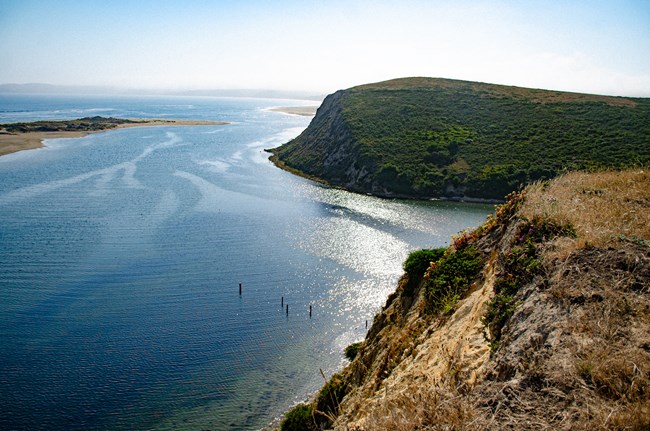Last updated: August 15, 2024
Article
You Otter be Kidding Me, Sea Otters in Point Reyes? Research Uses New Predator-Prey Model to See if it Could Work
By Science Communication Assistant Gavin Healy, San Francisco Bay Area Inventory & Monitoring Network Science Communication Team

Samantha Hamilton
July 2024 - I didn’t know what I was expecting when I asked two friends about their thoughts on sea otters. Maybe the usual expressions of how cute/precious/adorable they are. Instead, I was hunched over, howling as they shared their disdain over the amount of attention sea otters get. “They’re like so overrated in terms of cuteness,” one said. Whether or not you think they’re cute, southern sea otters are important coastal predators that help maintain whole underwater ecosystems. And they’re a federally-threatened species, still struggling to fully recover after a brush with extinction. So recently, a team of scientists chose southern sea otters to test if predator-prey population dynamics modeling could help conservation planners figure out where predator reintroductions could work. The team, partially funded by the National Park Service and Point Reyes National Seashore Association, published their results in Biological Conservation in June. They found that two estuaries in Point Reyes National Seashore could probably feed lots of cute (or not) whimsical water weasels one day!

NPS / Environment for the Americas / Gavin Healy
Scientists have been pleased with sea otters' recovery in Central California, but over the last decade they’ve noted stagnation. The otters have been unable to expand their range back to its former reach as a result of being hunted by white sharks along parts of the coast. The research team set out to model sea otters returning to Drakes Estero and Tomales Bay on account of their protected status and natural protection against white sharks, which don't call estuaries home.
The researchers’ process involved collecting new data, developing a model with existing species data, refining the model, and running the model. To collect data, the research team set out to the two Point Reyes estuaries where they got permits to collect drone imagery to map the amount of sea otter seagrass habitat. They also estimated the abundance of habitat-specific sea otter prey—crabs and clams—from surveys at both sites, as well as at Elkhorn Slough, an estuary that’s already seen great sea otter recovery.

Samantha Hamilton
The research team also built upon an incredible array of previous work. They used existing data and observations on sea otters, ensuring that the new model took into account things such as time spent foraging and energy gained from eating prey. The team then used a combination of ecological (i.e., predatory-prey interactions) and survey (i.e., otter and prey abundance) data from Elkhorn Slough to refine their model and ensure it accurately predicted how otter and prey populations really changed there. This way, the model could be accurate enough to help make complicated decisions that can impact entire ecosystems.
Finally, the team ran their model using the prey data they collected at Tomales Bay and Drakes Estero. The two scenarios they tested, including one where Point Reyes clams and crabs replenish half as fast as at Elkhorn Slough, look quite promising. Overall, total California sea otter population could jump by as much as eight percent, providing a much-needed win for southern sea otter recovery. Together, Drakes Estero and Tomales Bay could support 80 to 160 otters. The benefits to the estuary ecosystems could be just as grand.

NPS / Environment for the Americas / Gavin Healy
The presence of sea otters in Point Reyes could mean an assortment of fantastic, and also possibly challenging, things for the area. People could glimpse the new North Bay residents while hiking the park’s idyllic Estero Trail. Seagrass genetic diversity could increase as a result of decreasing clam and crab populations (sea otter prey)— plus seagrass meadows could possibly become more resilient to disturbances. Marsh erosion could decrease. However, it is not all perfection and guaranteed success. The study authors noted that sea otter presence could alter recreational crab and clam harvesting in the Point Reyes area, decreasing crab and clam populations. Oyster farms in Tomales Bay could need to prepare in case sea otters develop a taste for oysters. Here at Point Reyes, National Park Service biologists also wonder about how otters would interact with local harbor seal populations.
Reintroduction is a live experiment of sorts, and that means there can be many surprises—both positive and negative. But the team hopes their model results can help the U.S. Fish and Wildlife Service make decisions around potential otter reintroduction. The agency is exploring possibilities not just in and around Point Reyes, but at other sites throughout northern California and all the way up to Oregon. There isn't an actual reintroduction proposal so far. Regardless of what happens with otter reintroduction, the research team’s modeling work can also be applied to a variety of other decisions. Conservation managers can use the tool to better predict how other key predators will interact with their various prey—quite the step forward in using models to make conservation decisions easier.
For more information
- Learn more about California/Southern Sea Otters
-
Hamilton, Samantha N. M., M. Tim Tinker, Joseph Jackson, Joseph A. Tomoleoni, Michael C. Kenner, Julie L. Yee, Tom W. Bell, Max C. N. Castorani, Benjamin H. Becker, and Brent B. Hughes. 2024. Modeling coupled dynamics of an empirical predator-prey system to predict top predator recovery. Biological Conservation 294: 110623.
See more from the Bay Area Nature & Science Blog
